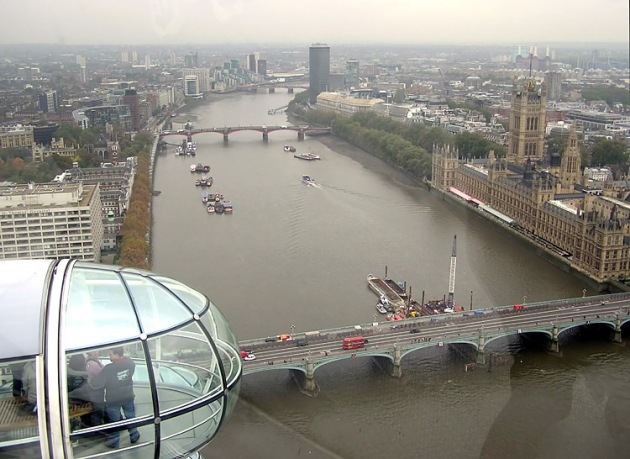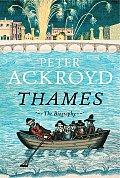Archimedes and the Plesiosaur
/Thames: the Biography
By Peter AckroydNan A. Talese, 2009I suppose I am what Peter Ackroyd would call a denizen of the river, a riparian inhabitant even - he is very fond of words like riparian. If you crane your head out of my front window you can just see the gray slither of the Thames as it slips beneath Battersea Bridge, watched by a statue of Whistler who so exalted in its gray and silver waters. Then it slithers onward to the Chelsea Embankment, and the pretty pink of that most fey of bridges, the Albert Bridge, passing the garden that once belonged to Thomas More’s daughter and a statue of the man himself with a golden face, passing the homes of Carlyle, Rossetti and Swinburne, and the host of artistic ghosts that colonized this stretch of the river in Victorian times; past the grounds of the Royal Hospital where there were pleasure gardens once and Mozart played, past the pallid facades of Pimlico and the steps of the Tate, and onwards to the mother of all parliaments, who sits on its bank, pregnant with her brood of boisterous commoners and venal peers of the realm.
James McNeill Whistler's Nocturne: The River at Battersea, 1878
And as the Thames runs on, never so sweetly as Spenser would have us believe, it gets wider and greyer and more turbid, and the buildings that crowd around it take on the same grayness, as if they were soaking it up. As Ackroyd says, the inhabitants of the surrounding buildings pay little attention to the river. They might occasionally notice it when they cross a bridge. As they cross what was once known as the wobbling bridge, until the engineers rectified its wobble, they might stop to gaze into the river’s depths. ‘There is something consolatory about bridges’, Ackroyd tells us, ‘They have borne many millions of footsteps, and have thus been rendered holy by time’. I suppose this cannot yet be said of the Millennium Bridge, since it has only been in place less than a decade and has some way to go before it becomes holy, but in fact there are no ancient bridges along the Thames - unless you go as far upriver as Radcot. The Londoners were imprudent enough to tear down their superbly quaint and many-arched and frankly dangerous Old London Bridge, even though it had survived the Great Fire. By now it would be the greatest tourist attraction in Europe, with a million tourist guides every year pointing out the place where the traitors’ heads were left to rot on spikes.But Thames: the Biography is not really concerned with the antiquity of the bridges. Peter Ackroyd is fascinated by the primordial agelessness of the river itself. It is this quasi-mystical quality that he strains for again and again, leaving his readers with a growing fatigue that would drive any sensible person to pause and rest for a moment. And, even in rest, the reader must still expect to be lost in a state of awe: ‘People tend to take up the same position while resting on a bridge, their bodies slightly forward, their arms leaning on the parapet, looking over the water.’ Well, yes, and it is supposed to contribute to the sense of the immemorial and the atavistic (another favorite word) that people do this, but one might ask what else they’re supposed to do - it’s the only way to see over into the water. There are times when the fatigue of looking into, or at, rivers is so profound that people are left unable to articulate anything even vaguely equal to the situation. I was reminded of an account of John Major in Prague when the Prime Minister visited the Charles Bridge with the Czech President. At one point the PM was seen to lean over the parapet in just the way described here, and then, turning to President Havel, said “So, the river runs under here, does it?” Trust John Major to be alive to the banality of his situation.Banality of that caliber can be breathtaking, but it would be unfair to this book to accuse it of depths, banal or otherwise. In fact, a lot of the time we seem to be lost in one endless encyclopedia entry, what Ackroyd himself has called a synopsis, with lists of the number of churches along the river that have associations with the Virgin, or digressions on nymphs - NYMPHIS LOCI BIBE LAVA TACE sounds like doubtful advice when it comes to the Thames (“The places of the nymphs – drink, wash, and be silent”), but Ackroyd doesn’t think so - or on the different tribes inhabiting the Northern and Southern shores - no mention, however, of the urban myth concerning the prevalence of bed bugs in the South, unable to cross the flood - or the various species of fish that have swum in it, or the nasty effluent (best not gone into in quite this much detail) that led to the “Great Stink” of the nineteenth century, or the various people, some pretty dubious, who worked on it, and even the reputation they had for being coarse and foul-mouthed. These riparian types are a good example of the drawback of all this listing. Unlike in his marvelous book on Blake, Ackroyd here rarely gives us a glimpse the actual lives and the language of these people. He is too chaste for that, and too much in a hurry to disclose the next fact. In his biography of Blake, he was able to range from the sublime of the poet’s visions to the remark he made about Fuseli: “The only Man that e’er I knew / Who did not make me almost spew.” So where are the instances of cockney slang to illustrate the point about the river’s vulgarity? Alas, they must be as much a fading memory as old Billingsgate itself.

The Thames from the London Eye. Lambeth Bridge is the central of the three.
The glimpses we get of the river’s people are from afar, well out of earshot, and there is little to illustrate the sense of license and liberty that the river apparently attracts. He never mentions the cardboard city and its inhabitants, for example. His only way of depicting the world turned upside down is the reflection in the river’s surface, a feature the Thames shares with every river on the planet. There’s no reference to the Sex Pistols’ famous prank, singing “God save the Queen, / The fascist regime!” from a boat on the river to celebrate the monarch’s Jubilee. There’s no reference to the nickname of the City Hall, the Gonad, which even Boris Johnson (London’s clownish mayor) has joked about. There are no visits to the pie and mash shop to eat jellied eel, or descriptions of the street artists along the South Bank. The book lacks any of that famous London cheekiness and ribaldry and instead has the same mood music of stately portentousness throughout. It’s as if we’ve been put on hold and forced to listen to Handel’s Water Music for hours on end.'The water of the Thames may once have fallen from the back of a plesiosaur or filled the bath of Archimedes,' he tells us, though this may equally well be said of a stagnant puddle in Minsk. I don't know which shocked me more, the frolicking plesiosaur or the stark naked mathematician, though on most days the river undoubtedly has the color of bathwater. 'That is where the enchantment of the river lies. It is the deep and ancient force of creation. The noise of its waters is the sound of burgeoning life. "And all the liquid world", as Abraham Cowley put it, "is one extended Thames."' I hate to sound a note of skepticism, but Ackroyd has told us before that the enchantment lies in the fact that the river is not owned by anyone, or in its association with Isis, etcetera. It's as if he flails about throughout the book trying to identify just why he has bothered to talk about the river at all, and it's typical of his desperation to resort, in a vague reference, to 'the sound of burgeoning life' - I have never heard it, but could one hope to, outside a maternity ward? - and follow up with Cowley's throwaway proposition, lifted from its context and emptied of meaning.
| The unintended effect of these quotations is much-needed light relief from his otherwise dependably prosaic style: the lists, the strange syntax ('There have been discovered more than eighty Neolithic settlements in the course of the Middle Thames...'), the effort once or twice a chapter to get a handle on what it is he would like to tell us about the poor, weary old runnel. 'There seems to be a tendency in the writers of prose, to break into verse in the course of their narratives' - is this perhaps what Ackroyd would like to do? - 'as if the river itself elicited a less than prosaic response.' Less than prosaic? Hang on a minute... Or else just give us another list, and stop waxing less than poetical on us. |  |
And so the lists resume. Lists of boats, or of drowned persons, lists of artists, or of literary chaps, and of course Ackroyd finds his soul-mate when he arrives at Conrad, for whom the river had a ‘strange air of mysteriousness.’ Conrad started Heart of Darkness with a description of the Thames, and in a few sentences managed to evoke more menace and atmosphere than all Ackroyd’s almost five hundred pages. He has a Roman approaching it at a time before civilization, when it seems like ‘the very end of the world, a sea the color of lead, a sky the color of smoke’ - an alien Thames, primeval, and savage as the Congo itself, and for Conrad it wasn’t just a Roman who might see it that way. On a typical winter’s day it might as well be anyone leaning on the parapet of any of its bridges. This surely, and the passage across those bridges of Eliot’s lost souls, is the landscape that typifies the Thames and distinguishes it from the sweating Tiber, or the amorous Seine. There’s something foul about it, more like a sump than a body of water.It was Morrissey, bless him, who moaned sweetly once of ‘drinking tea with the taste of the Thames’. There are times, reading this long and yet short-winded book, when you feel like you’re being forced to swallow gallons of the stuff - times, in short, when you are at risk of drowning in gray facts.___Bryn Haworth was born in Essex and is working on a book. He resists all negative connotations associated with either of those facts.Return to the Main Page







